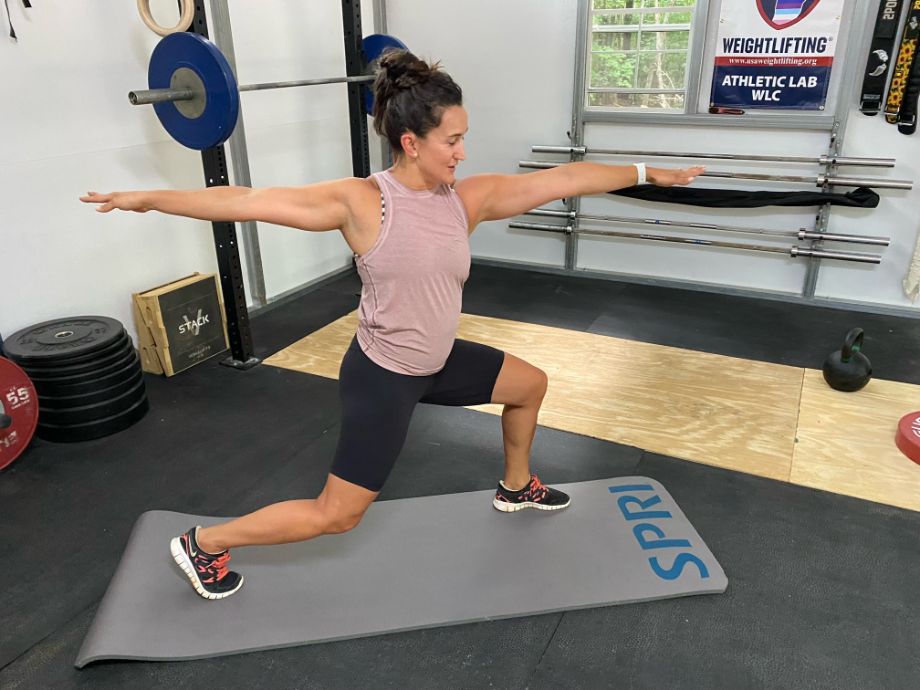We test and review fitness products based on an independent, multi-point methodology. If you use our links to purchase something, we may earn a commission. Read our disclosures.
As a yoga instructor of all types—from hot to Hatha to restorative—I’ve seen firsthand how yoga poses can help create strength, build body awareness, and alleviate anxiety. I also know that getting started with a yoga practice can be intimidating. But you don’t have to go straight into a handstand to get benefits from yoga! Plenty of physical postures, or “asanas,” can help you gain strength, improve your posture, and even combat chronic pain without twisting yourself into full lotus. All you need is one of the best yoga mats and a little bit of guidance.
Here’s a list of the 14 best beginner yoga poses to get you on your way to being a practicing yogi followed by a few benefits of incorporating the yoga practice into your fitness routine.
RELATED: Down Dog App Review: 2024
14 Best Yoga Poses
- Child’s Pose (Balasana)
- Cat-Cow (Marjaryasana – Bitilasana)
- Bridge Pose (Setu Bandhasana)
- Tree Pose (Vrksasana)
- Pigeon Pose (Ardha Kapotasana)
- Downward Facing Dog (adho mukha svanasana)
- Cobra Pose (Bhujangasana)
- Mountain Pose (Tadasana)
- Chair Pose (Utkatasana)
- Warrior I (Virabhadrasana I)
- Warrior II (Virabhadrasana II)
- Happy Baby Pose (Ananda Balasana)
- Supine Spinal Twist (Supta Matsyendrasana)
- Corpse Pose (Savasana)
Child’s Pose
Muscles worked: Lats, traps, erector spinae, hip flexors, obliques, glutes
Benefits: Child’s pose is a great place to start your yoga practice because it allows you to connect to your breathing and tune in to how you’re feeling and what your body needs. It’s also a great reset or rest position throughout your practice.
How to do it:
- Kneel on your yoga mat.
- Position your knees outward (wider than your hips) and bring your big toes toward each other until they’re touching behind you.
- Walk your hands forward toward the top of your mat until your forehead is resting on the floor.
- Allow your hips to rest down toward your heels.
- Hold the pose for time or until you feel ready to flow into your next movement.
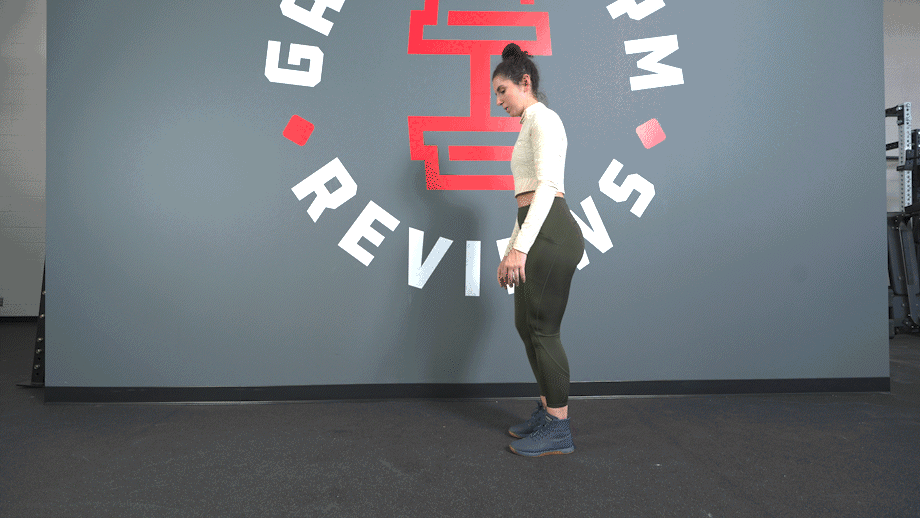
Modifications
- Dial it back: People with very tight hamstrings may find Child’s pose challenging. For extra support, you can place a rolled blanket or bolster behind your knees.
- Make it harder: Walk your hands to the top left of your mat to get an additional stretch in your lats, then switch sides.
Cat-Cow (Marjaryasana – Bitilasana)
Muscles worked: Erector spinae, shoulders, hip flexors, core
Benefits: Cat-Cow is a great pose for spinal longevity. This gentle movement helps lubricate your individual vertebrae and can build strength and mobility.
How to do it:
- Come to your hands and knees on your mat.
- Stack your hips directly above your knees and your shoulders directly above your wrists. Allow for a tiny bend in your elbows so they’re not locked out.
- Drop your belly toward the floor while lifting the crown of your head and your tail bone toward the ceiling (cow).
- Drop the crown of your head and tailbone toward the floor while reaching the center of your spine toward the ceiling (cat).
- Alternate between cat and cow for time.
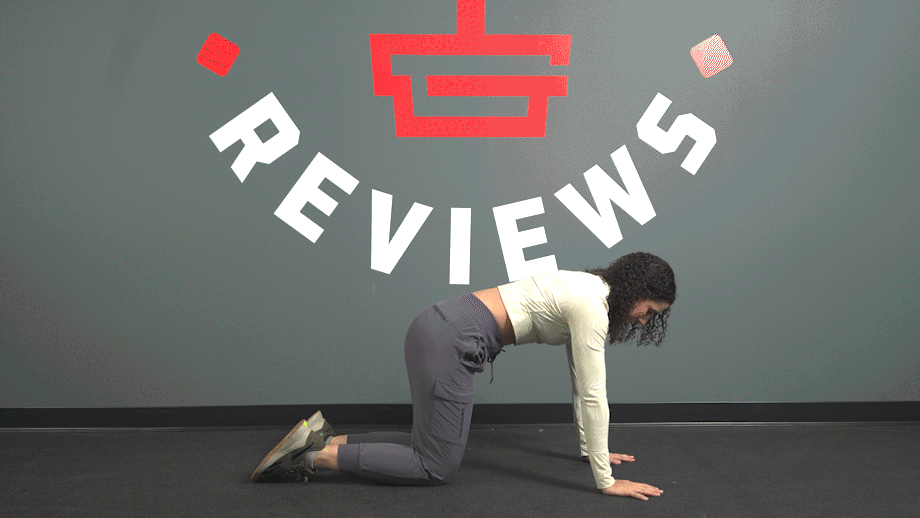
Modifications
- Dial it back: No need to go to your extreme right away! Be gentle with your spine as you explore this movement.
- Make it harder: You can add in a circular movement or side-to-side swaying and curves as you get the hang of this motion.
Bridge Pose
Muscles worked: Hip flexors, glutes, upper and lower back, abs, hamstrings
Benefits: Bridge is a backbend that builds strength in your glutes and upper back while stretching the hip flexors. Over time, this pose will also increase flexibility in your back and thoracic mobility.
How to do it:
- Lie on your back (supine) with your knees bent and the soles of your feet flat on your mat.
- Press into the soles of your feet and begin to lift your hips off the ground.
- Continue pressing until your hips lift as high as they can without overexerting your muscles.
- Hold for time, then slowly lower your hips back to the ground.
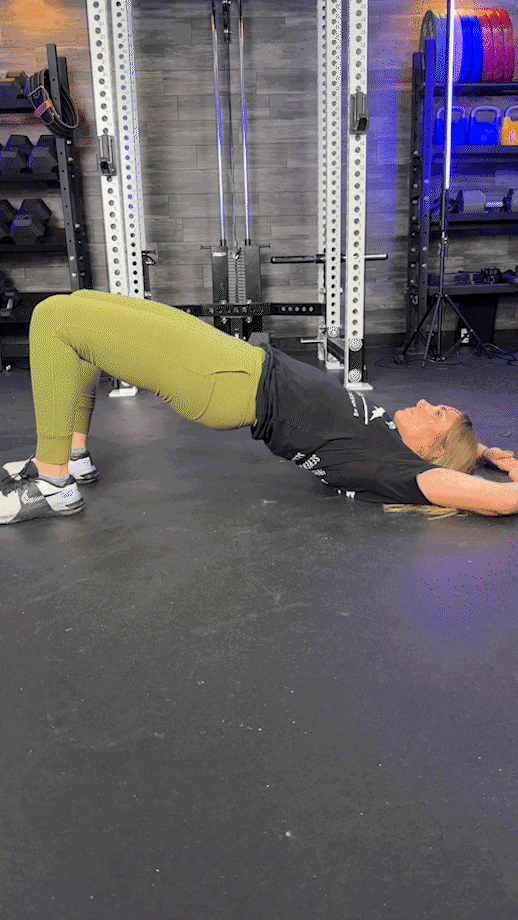
Modifications
- Dial it back: Place a yoga block underneath your hips for support
- Make it harder: When you’re at the peak of your bridge, clasp your hands behind your back and work your shoulder blades towards each other underneath your body. Press into your forearms to help lift your hips higher.
RELATED: How To Do The Pelvic Tilt Exercise.
Tree Pose
Muscles worked: Core, shoulders, hip flexors, hamstrings, calves, ankles
Benefits: Tree pose helps improve your balance and proprioception for better posture and functional fitness.
How to do it:
- Bring your hands to your sternum, palms facing one another and choose a standing leg to balance on.
- Lift the opposite foot and draw the sole of the foot to meet the inner calf of your standing leg.
- Hold this posture for three to five rounds of breath.
- Repeat on the other side.
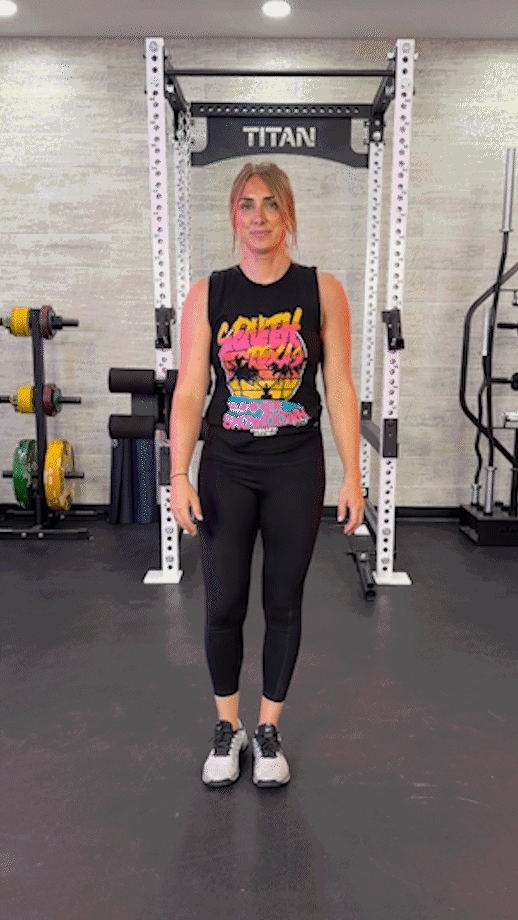
Modifications
- Dial it back: Rest the toes of your lifted foot on the ground next to your standing foot to help with balance
- Make it harder: Raise the sole of your lifted foot higher to the inner thigh of your standing leg.
Pigeon Pose
Muscles worked: Hip flexors, glutes, lower back
Benefits: The pigeon pose creates a deep hip stretch that’s excellent for helping open tight hip flexors and improving your range of motion. It’s also a great method of easing tension in your lower back, especially if you sit at a desk.
How to do it:
- Fold forward at your hips with your feet a hip-width distance apart.
- Walk your hands out in front of you about four to five feet, depending on your height.
- Step your right leg forward and lay your right shin on the mat so your right ankle is behind your left hand and your right knee is behind your right hand. Bend your right knee any amount that feels comfortable.
- Lower your hips toward the mat with your left leg lengthened behind you. Feel free to use a pillow underneath your hips for additional support.
- Hold this posture for three to five rounds of breath.
- Push yourself back up and repeat on the other side.
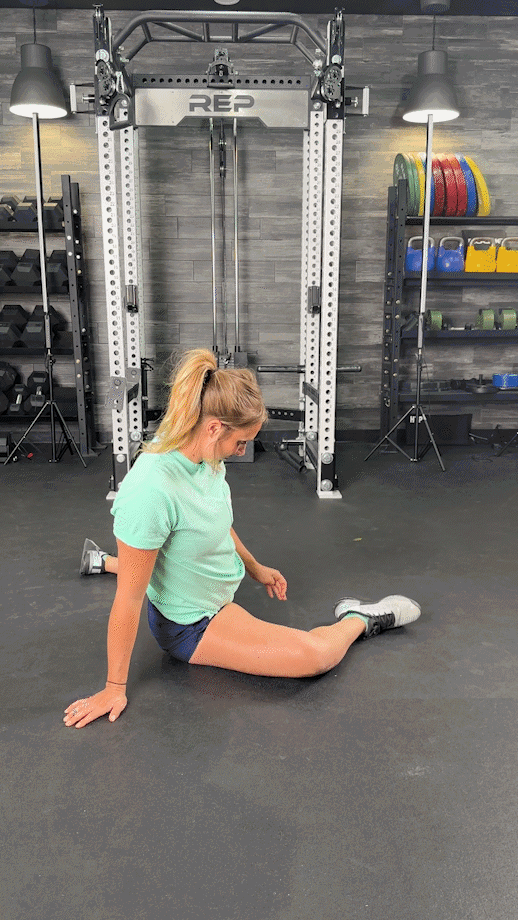
Modifications
- Dial it back: Pigeon on your back, or supine pigeon, can be done as a “figure four,” lying on your back with the outside of one ankle resting on the bottom of your opposite thigh.
- Make it harder: After settling into the stretch, lean forward from your torso so that your upper body and forehead rest on the floor in front of you or a yoga block.
RELATED: Office Workout
Downward Facing Dog
Muscles worked: Arms, traps, quads, wrists, erector spinae, calves, ankles
Benefits: Arguably one of the most popular yoga poses, Downward Facing Dog is what’s known as an inversion—which means your hips are higher than your heart. This particular inversion pose helps strengthen your arms, stretch your hamstrings, and can help alleviate lower back pain.
How to do it:
- From standing with your feet hip-width apart, fold forward at your waist so your hands are reaching toward your mat.
- Bend your knees any amount and walk your hands out in front of you about two-thirds to three-quarters of your body height, or until your upper body and lower body make opposing 45-degree angles to the floor. You should look like a triangle, with your hips being the top of the triangle and where your hands and feet meet the mat as the other two points.
- Hold for time.
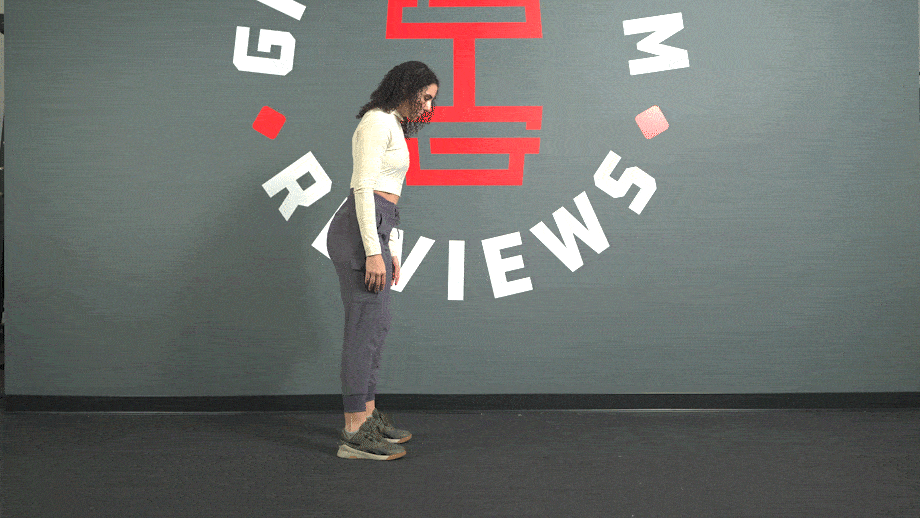
Modifications
- Dial it back: Bend your knees as much as you like to help alleviate pressure on your wrists and ankles.
- Make it harder: With straight legs, press your heels down toward the floor.
Cobra Pose
Muscles worked: Gluteus maximus, quads, lower back, chest, hamstrings, spinal extensors
Benefits: Cobra pose is excellent for helping build up your lower back strength and flexibility.
How to do it:
- Lie on your mat face down (prone) with your feet hip-width distance apart.
- Place your palms on the floor beneath your shoulders, elbows tucked in by your sides.
- Press into your palms to lift your upper body off your mat until your arms are straight (don’t lock out your elbows!) and your hips remain on the ground.
- Keep your neck in line with your spine, eyes forward.
- Hold the pose for time before lowering your upper body back down toward your mat.
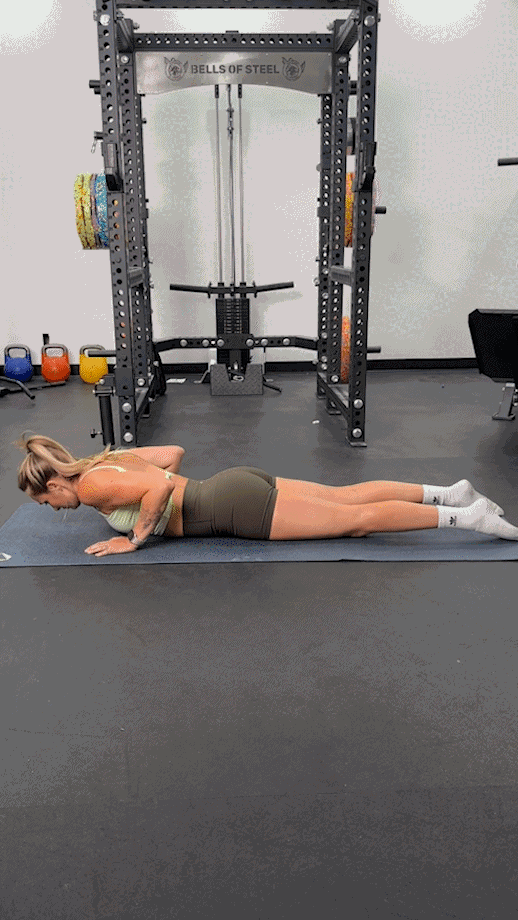
Modifications
- Dial it back: Keep your elbows bent and tucked in by your sides. Lift only your head and chest. Your ribs and stomach should remain on the mat.
- Make it harder: After lifting your upper body off your mat, walk your hands forward about one palm distance for a posture called Seal Pose.
Mountain Pose
Muscles worked: Quads, calves, glutes, thighs, ankles
Benefits: Known as “Tadasana” in Sanskrit, Mountain Pose is the shorthand in yoga for “standing up straight with correct alignment.” It’s a great place to start waking up your mind-body connection, and you can do this pose anywhere.
How to do it:
- Stand facing forward with your feet flat on the mat, hip-width distance apart, and your weight evenly distributed across your feet.
- Press into your feet with straight legs, making sure not to lock out your knees.
- Point your tailbone down toward the ground avoiding an anterior (front) or posterior (back) tilting motion with your pelvis.
- Draw your shoulders down and back, your palms may face slightly forward.
- Draw the crown of your head up toward the ceiling.
- Hold the pose for time.
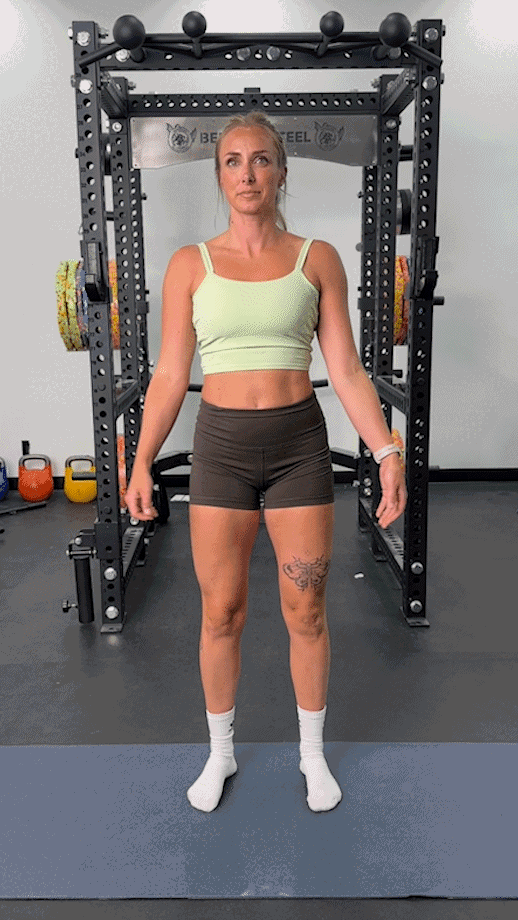
Chair Pose
Muscles worked: Quads, hamstrings, hip flexors, core, back, shoulders
Benefits: Chair pose is known for firing up the quadriceps, which means it’s great for building strength in your thighs. Chair pose over time will also increase mobility in your ankles and build better awareness for alignment in your legs and spine.
How to do it:
- Stand with your feet hip-width apart.
- Bend your knees as deeply as you can while keeping your torso lifted and your feet flat on the ground.
- Point your tailbone toward the ground avoiding an anterior (front) or posterior (back) tilting motion with your pelvis.
- Draw your low ribs in toward each other—this will engage your core muscles and help keep your torso lifted.
- Lift your arm straight up, your upper arms should be in line with your ears.
- Hold for time.
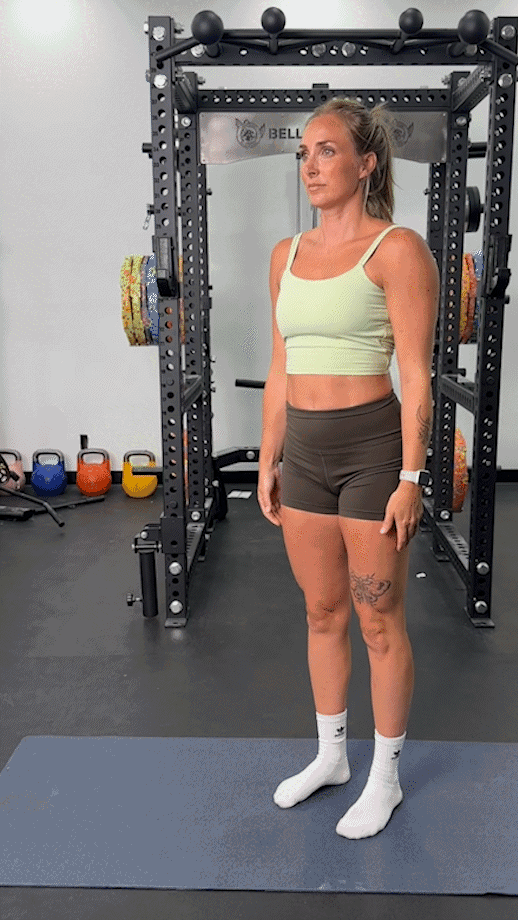
Modifications
- Dial it back: Bend your knees a little less or bring your palms together in front of you.
- Make it harder: Lift your heels and rise onto the balls of your feet, keeping the deep bend in your knees.
Warrior I
Muscles worked: Quads, hamstrings, glutes, hip flexors
Benefits: Warrior I is a variation on a lunge that stretches one leg while engaging another. It’s a great pose to work on balancing different elements at once, as proper execution depends on alignment and core engagement while maintaining a sense of ease in the upper body. Warrior poses like Warrior I and Warrior II are used in many Sun Salutations (or a sequence of yoga poses), so if you find yourself in a yoga class, you’ll be glad you know this one.
How to do it:
- Take a long step forward with your right foot. Bend your right knee and point your right toes forward.
- Spin your left foot out slightly—your foot should be at about a forty-five degree angle to the centerline of your mat.
- Press into the outer edge of your left foot.
- Lengthen through your side body as you reach your arms up toward the ceiling, palms facing each other.
- Return to the starting position and repeat the exercise on the opposite side.
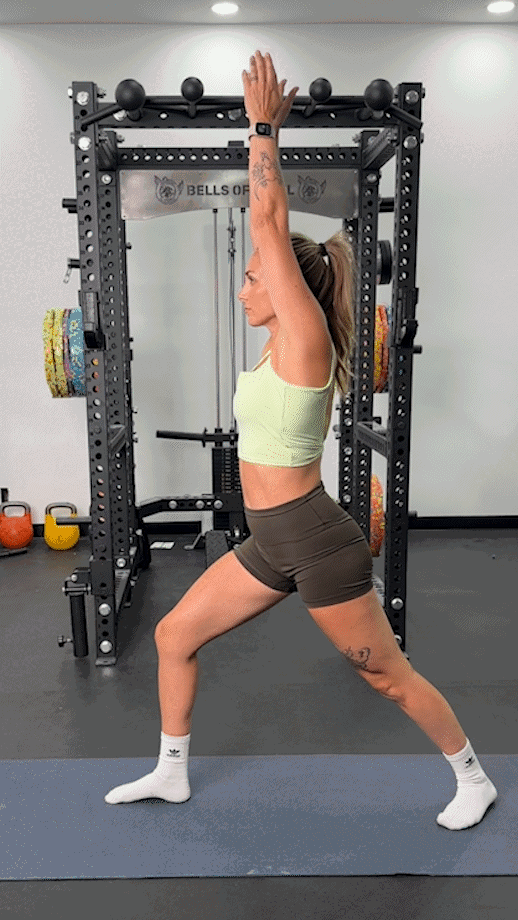
Modifications
- Dial it back: Bring your hands together at your sternum with your palms pressed together.
- Make it harder: Bend deeply into your right knee, keeping it in line with your ankle.
Warrior II
Muscles worked: Quads, hamstrings, glutes, hip flexors
Benefits: Warrior II is often practiced after Warrior I because the shapes can “flow” nicely from one to the next. Warrior II uses many of the same muscles as Warrior I, but introduces a hip stretch and an open upper body.
How to do it:
- From Warrior I, swing your back foot open so the outer edge of your foot is parallel to the back of your mat and your toes are pointing toward the left.
- Open up your torso—from your hips to your shoulders—toward the left side of your space while reaching your right arm forward and your left arm back.
- Look over your front fingertips and hold the stretch.
- Repeat the exercise on the other side.
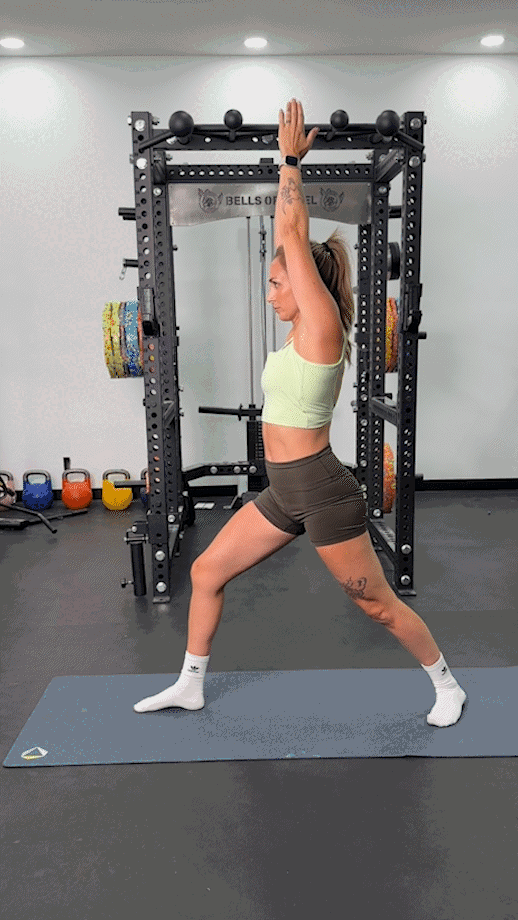
Modifications
- Dial it back: Bend your front knee less.
- Make it harder: Hold this pose for ten rounds of inhales/exhales.
Happy Baby
Muscles worked: Thighs, hamstrings, groin, hip flexors, lower back
Benefits: Happy Baby is an excellent release for your lower back, especially toward the end of a long yoga flow, and helps to stretch your hamstrings and hips.
How to do it:
- Lie on your back.
- Draw your knees in toward your chest.
- Grab on to the outsides of your feet with your hands.
- Find stillness or gently rock back and forth, massaging your low back with your mat.
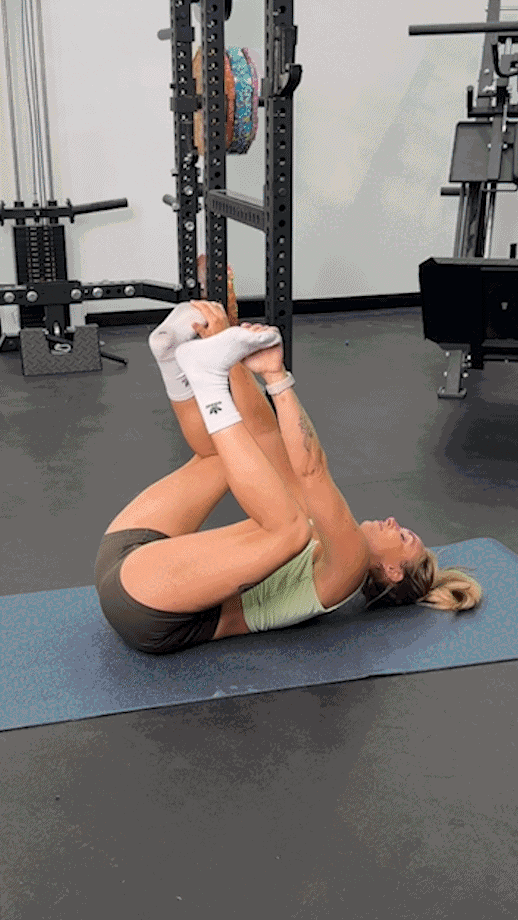
Modifications
- Dial it back: Instead of reaching for your feet, grab behind your knees or thighs.
- Make it harder: Try straightening one leg and then the other, allowing the movement to rock you back and forth on your mat.
Supine Spinal Twist
Muscles worked: Glutes, lower back, chest, obliques
Benefits: Supine Spinal Twist allows you to use gravity to help stretch and release your lower back muscles.
How to do it:
- Lie on your back.
- Draw your right knee in toward your chest.
- Cross your right knee over to the left side of your body, allowing your torso to twist.
- Bring your arms to a “T”: left and right arm open and flat against your mat.
- Lift your right leg back to center and repeat the exercise on the opposite side.
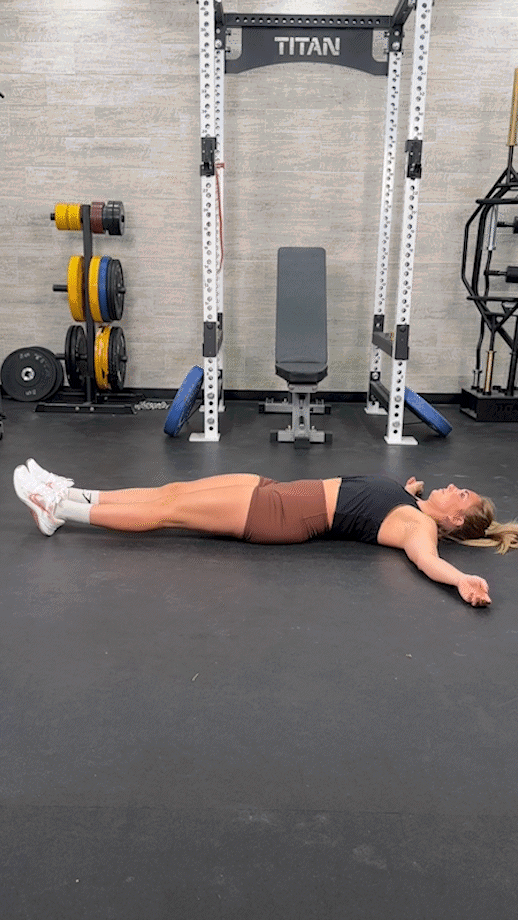
Modifications
- Dial it back: Lie on your back with your knees bent and soles of the feet flat on your mat. Drop both of your knees to the left, then repeat the movement on your right side.
- Make it harder: Press your right shoulder blade toward or into the ground as you twist.
RELATED: 14 Cool Down Exercises To Increase Your Flexibility And Recovery
Corpse Pose (Savasana)
Muscles worked: Nearly all muscle groups!
Benefits: Savasana is a meditative posture traditionally taken at the end of a yoga practice as an opportunity for your mind to observe your body while your body is completely at rest. This is a great place to incorporate pillows, bolsters, or other supports to help your body relax as much as possible. You can practice this posture for as long as you’d like, but I highly recommend aiming for at least five minutes.
How to do it:
- Lie on your back on top of your mat.
- Place your arms long by your sides, palms facing up.
- Place your feet about hips width distance apart and relax your legs.
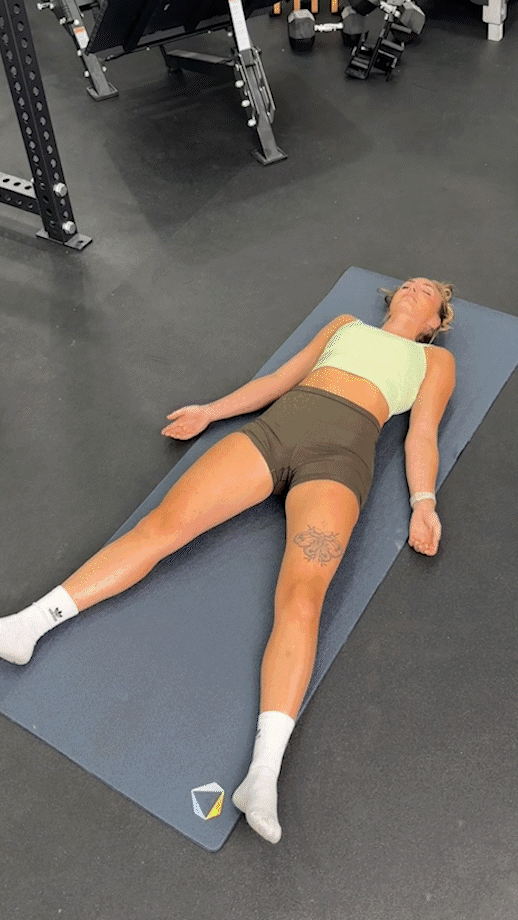
Note: Many of the muscles worked and benefits of these poses were referenced using the book Science of Yoga1 by Ann Swanson.
Types of Yoga Poses
Now that you have the information you need to get started, here’s a quick overview of how to categorize the different types of yoga poses:
- Standing: As you might expect, standing poses take place with both feet on the ground! Mountain pose, Warrior I and II, and Chair are all standing poses. There are also angle poses, such as side angle and triangle pose, which are both performed with your feet grounded.
- Balancing: Balance poses, as the name implies, challenge your balance and proprioception—sense of body awareness. Balancing poses are often performed on one foot (unilaterally) like Tree Pose.
- Twisting/hip-opening: These movements help open up your range of motion and increase flexibility. Child’s pose and pigeon pose are a couple of examples.
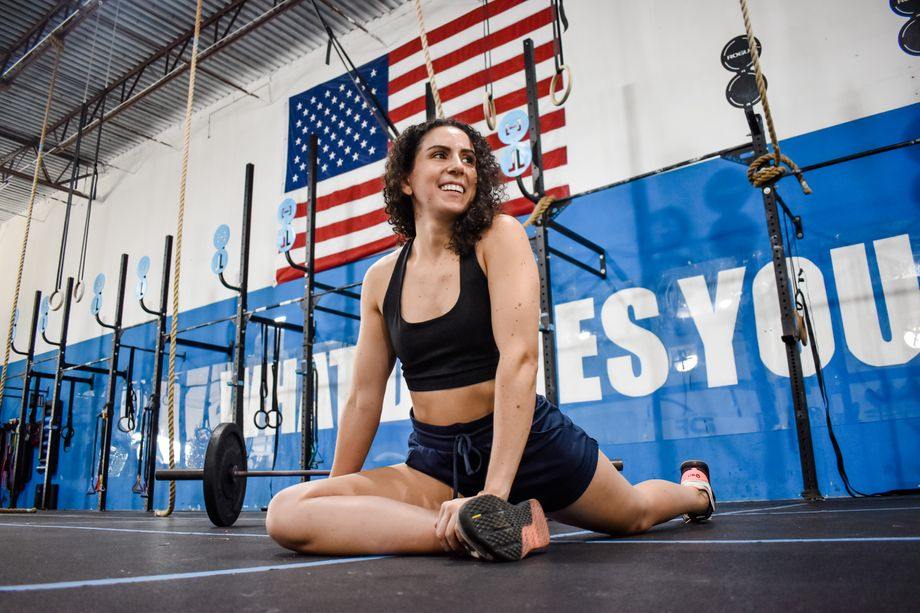
- Inversion: An inversion is any pose that places your hips higher than your heart. Headstand is an obvious example, but Downward Facing Dog, forward bends, and Bridge Pose are also considered inversions.
- Supine: Supine is a fancy way of saying “on your back.” A couple of examples of supine poses are Supine Spinal Twist and Savasana, both included on our list.
Benefits of Yoga Poses
Yoga boasts many health benefits, both physical and mental. As a yoga instructor and someone with a daily yoga practice, I’ve seen yoga poses help students gain strength, alleviate anxiety, and even diminish lower back pain. Yoga also focuses on breathing and building a mind-body connection, which can help prevent training injuries and aid in daily life activities.
Body Awareness
Body awareness is a general term covering everything from understanding where your body is in space to pain management to better understanding your internal body cues like hunger and sleepiness. According to an October 2023 study published in Perceptual and Motor Skills by Sage Journals2, people with a regular yoga practice have overall better body awareness.
Stress Management
Most know that engaging in physical movement of any kind can help you feel better due to the rush of post-workout endorphins. But, as referenced in this 2011 study published in the International Journal of Yoga3, a regular yoga practice has also been found to help regulate the parasympathetic nervous system, improve symptoms of depression, and increase serotonin production.
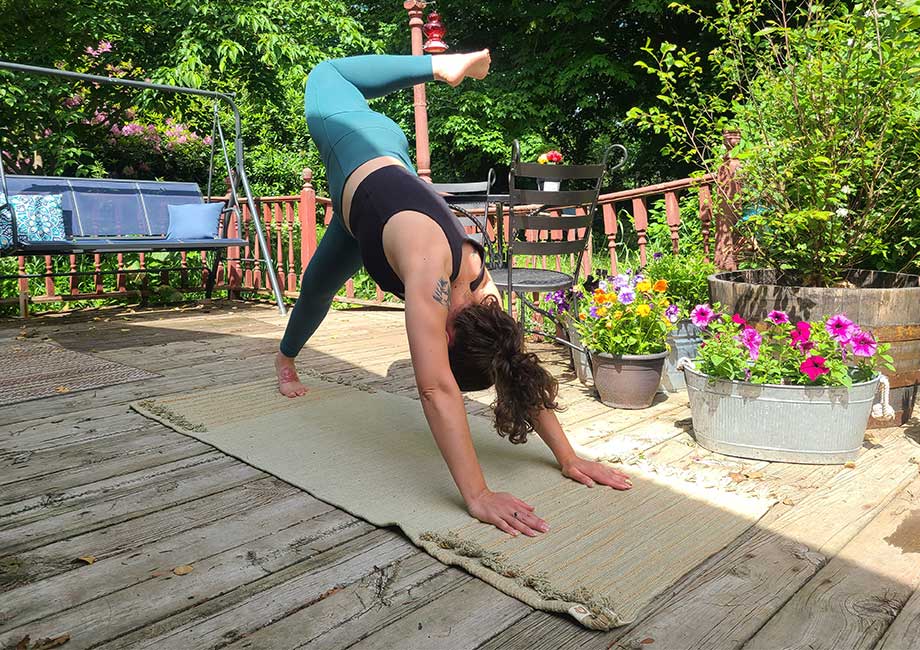
May Help Ease Lower Back Pain
A June 2023 study4 found that nearly 80% of adults will experience lower back pain at some point. According to a 2017 study in the Annals of Internal Medicine5, researchers found yoga to be as effective at reducing chronic back pain as physical therapy.
Yoga Poses: FAQs
What is the most common yoga pose?
As a yoga teacher, I see Downward Facing Dog is used frequently in yoga classes as a transition pose, particularly in many Vinyasa—or “flow”—classes.
What is the easiest yoga pose to learn?
While you might think Mountain Pose is the easiest, there’s a lot of subtlety in body alignment that can make it harder to do well at first. Everybody is different, but as a yoga instructor, I find Downward Facing Dog a more accessible place to start. The shape is different enough from everyday body postures, so it forces you to concentrate on what your body is doing.
What yoga should a beginner start with?
All forms of yoga have an entry point appropriate for a beginner. A lot of the answer to this question depends on what you want out of your yoga practice. If you love a good sweat session— try a hot yoga variety. Prefer to focus on something calmer and slower? Maybe restorative yoga or Yin yoga are closer to what you’re looking for.
Does yoga help you lose weight?
A September 2021 article by Harvard Health Publishing6 suggests that because yoga increases mindfulness in all aspects of life and because practicing yogis are more attuned to their body’s needs, yoga can help with weight loss and maintenance.
References
- Swanson, Ann. Science of Yoga: Understand the Anatomy and Physiology to Perfect Your Practice. DK Publishing, 2019.
- Sarak Kucukosmanoglu, H., Coskun, G., & Yosmaoglu, H. B. (2023). The Effect of Yoga Practice on Cervical Tactile Acuity and Body Awareness. Perceptual and motor skills, 130(5), 2031–2046. https://doi.org/10.1177/00315125231187435
- Woodyard C. (2011). Exploring the therapeutic effects of yoga and its ability to increase quality of life. International journal of yoga, 4(2), 49–54. https://doi.org/10.4103/0973-6131.85485
- GBD 2021 Low Back Pain Collaborators (2023). Global, regional, and national burden of low back pain, 1990-2020, its attributable risk factors, and projections to 2050: a systematic analysis of the Global Burden of Disease Study 2021. The Lancet. Rheumatology, 5(6), e316–e329. https://doi.org/10.1016/S2665-9913(23)00098-X
- Yoga, Physical Therapy, or Education for Chronic Low Back Pain. (2017). Annals of internal medicine, 167(2), 10.7326/P17-9039. https://doi.org/10.7326/P17-9039
- “Yoga – Benefits beyond the Mat.” Harvard Health, 8 Sept. 2021, Accessed July 2024 from: https://www.health.harvard.edu/staying-healthy/yoga-benefits-beyond-the-mat.
Further reading

We’ve compiled the best Memorial Day treadmill sales so you can be up and running toward your fitness goals without breaking your budget. Read more

As a yoga instructor of all types—from hot to Hatha to restorative—I’ve seen firsthand how yoga poses can help create strength, build body awareness, and alleviate anxiety. I also know that getting started with a yoga practice can be intimidating. But you don’t have to go straight into a handstand to get benefits from yoga! Plenty of physical postures, or “asanas,” can help you gain strength, improve your posture, and even combat chronic pain without twisting yourself into full lotus. » Read more about: Yoga Poses: The 14 Best Poses To Maximize Your Health Benefits From the Yoga Practice » Read more

In this Plunge Evolve Series review, a certified personal trainer takes a look at Plunge’s newest lineup of affordable cold plunge tubs and powerful standalone chiller system. Read more

In this Echelon Row-s Connected Rowing Machine review, I’ll tell you why this piece of cardio equipment might be a solid add to your home gym. Read more

